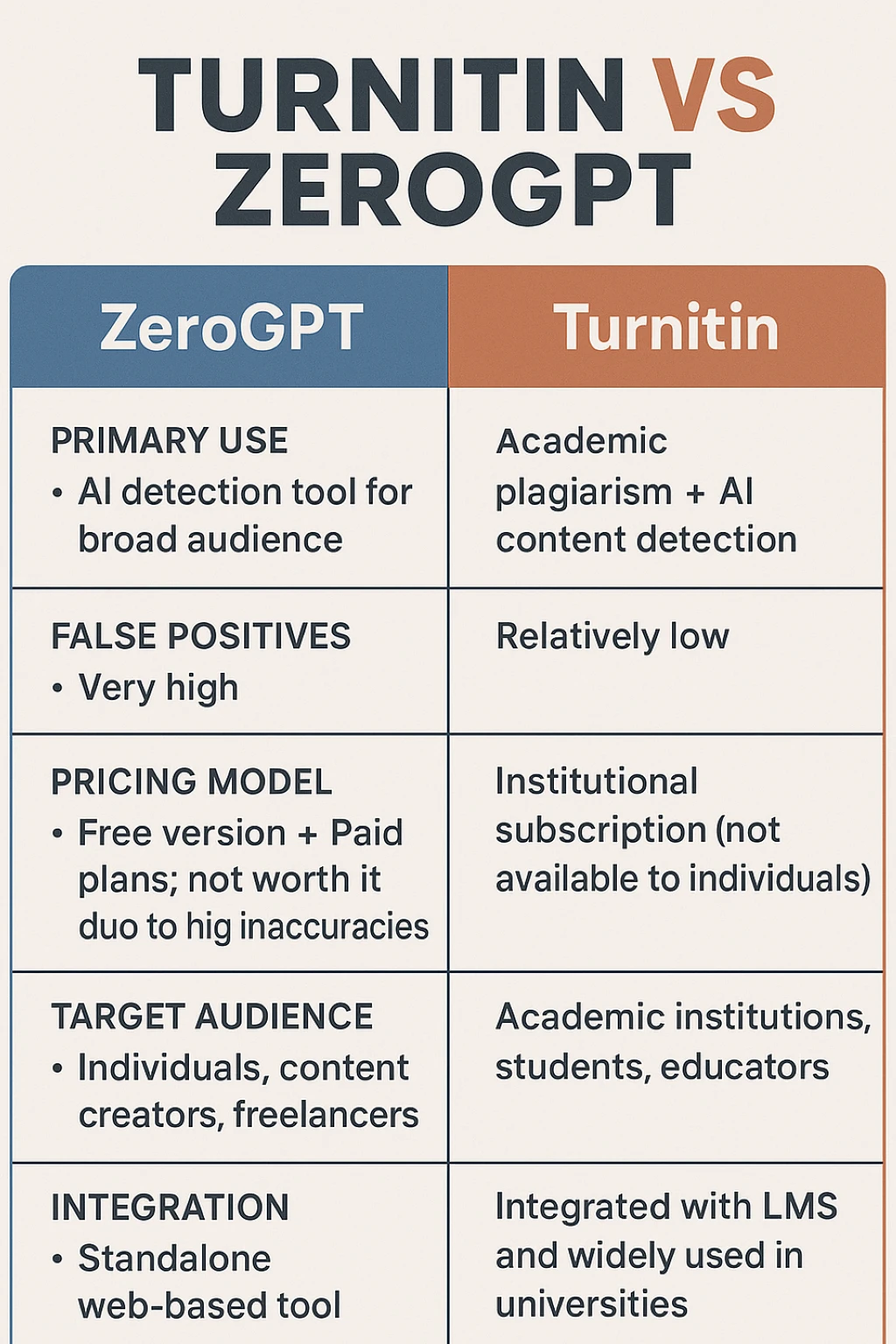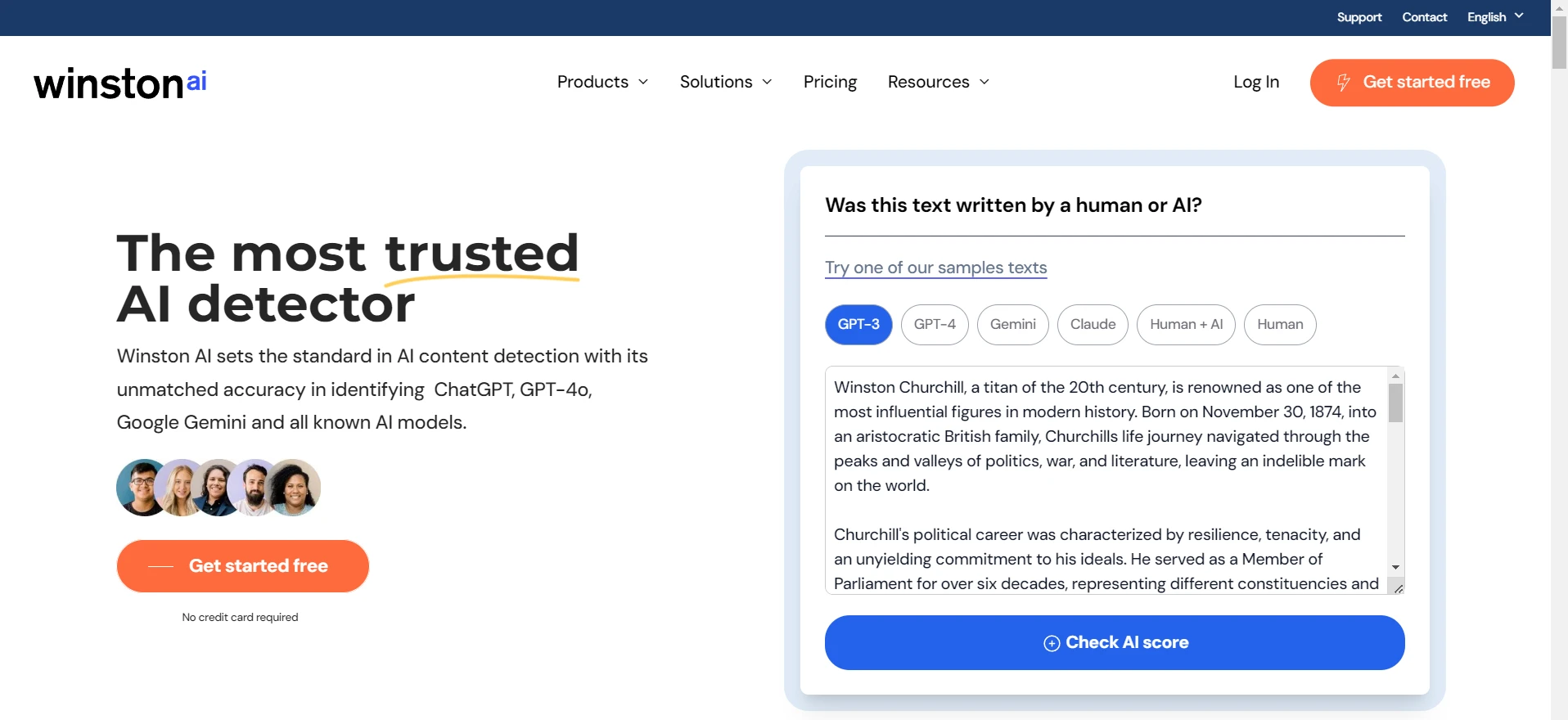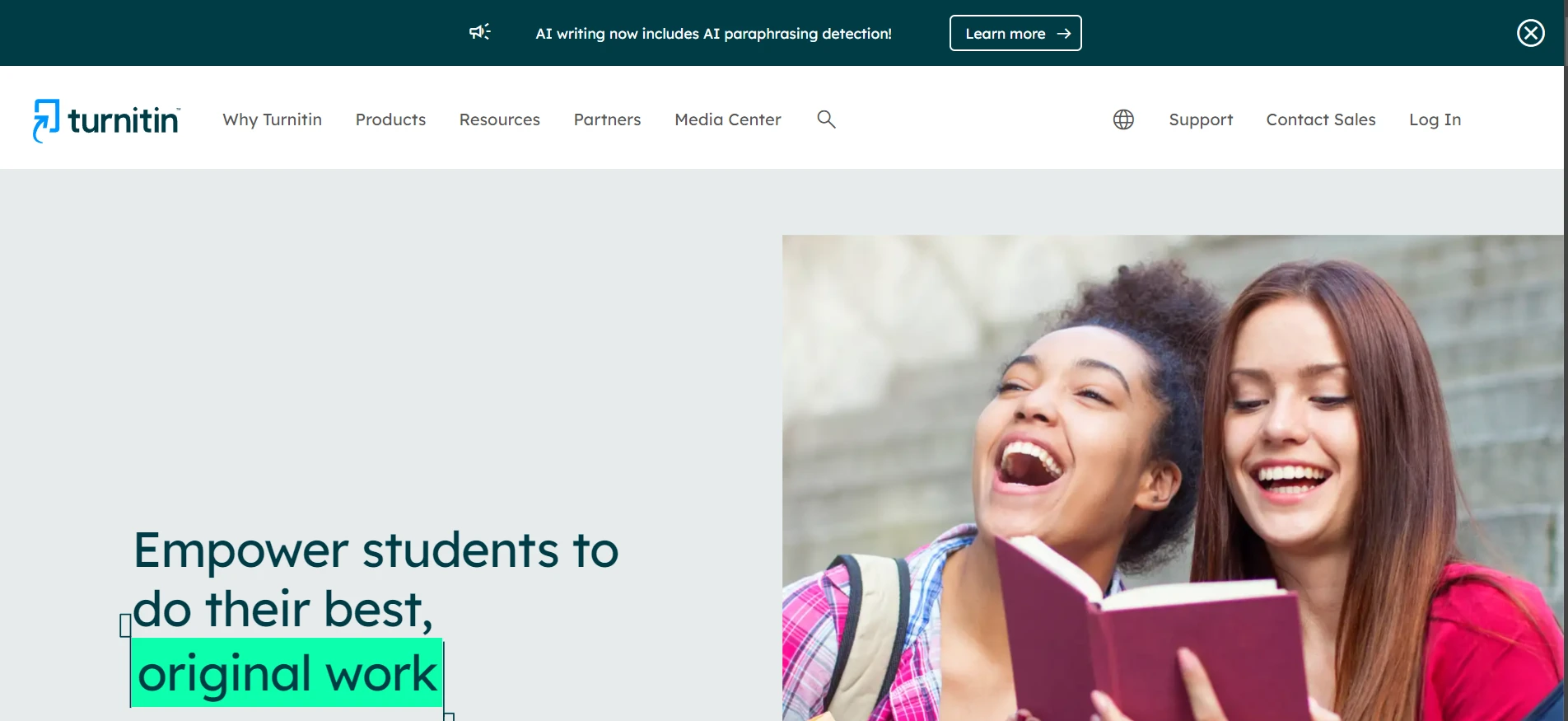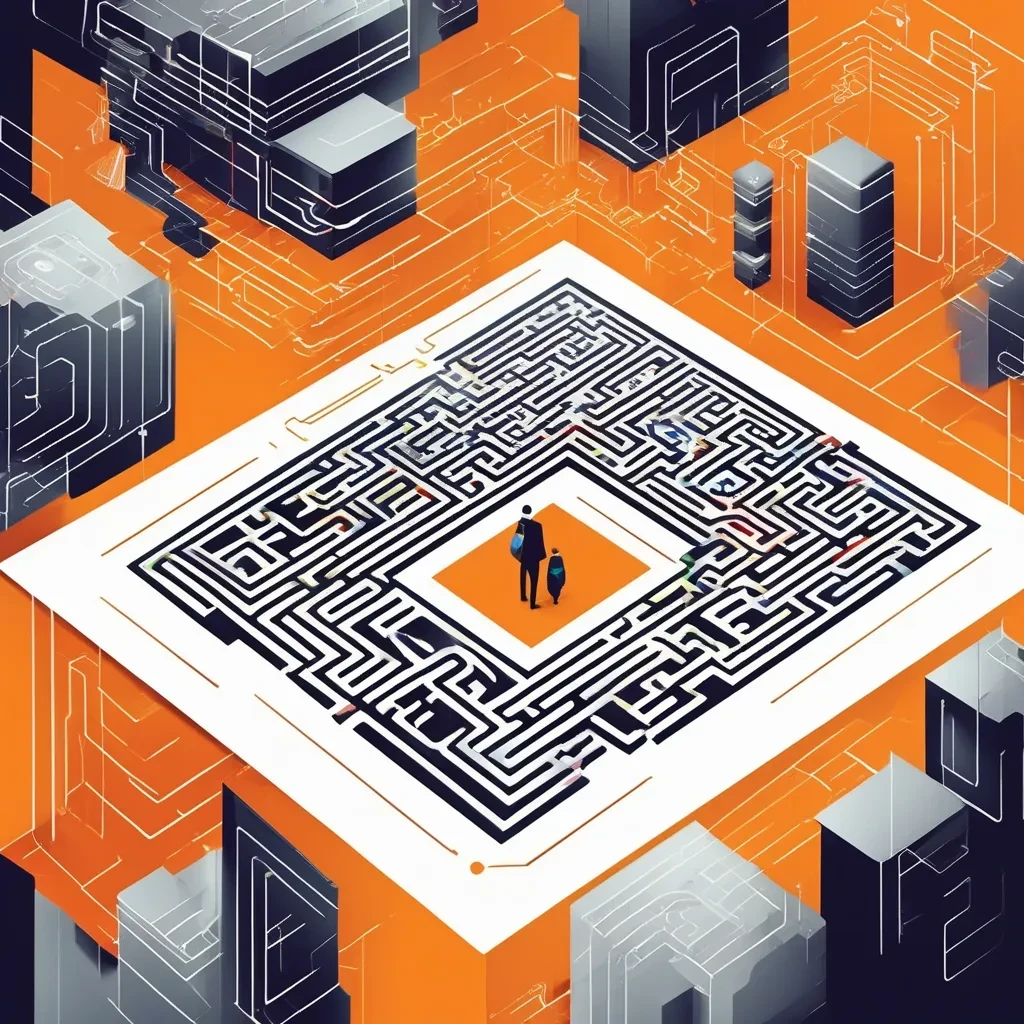As we all know it Turnitin has been the gold standard for plagiarism detection in academic institutions for years, but now they also have an AI detector thrown into the mix. On the other hand, ZeroGPT is a relatively new name in the world of AI detection tools. The short answer to which is better? Turnitin comes out on top. The longer answer is filled with details that I’m about to share with you all. Keep reading to know more about it.
Why Compare Turnitin with ZeroGPT?

The simple reason is that ZeroGPT claims to be an AI detection tool that caters to a broader audience, while Turnitin is mostly for educational institutions. However, the real question is which one does a better job at sniffing out AI-generated text. In my experince, Turnitin is far superior than ZeroGPT. Yes, it’s not perfect, but it definitely doesn’t produce the same kind of false positives that you’ll see on ZeroGPT.
Over the years, my single problem with ZeroGPT is that it has a lot of false positives. You could literally write a perfect English paragraph, checking all your grammar and syntax properly, and ZeroGPT might still decide to flag it as AI-generated. In short, it’s free, but you get what you pay for. If you’re a blogger, a student, or even a business professional who values accuracy, these false positives can be a deal breaker.
I would also strongly advise against going for their paid plans because of these false positives. It’s very likely you’d still get flagged if you tend to write using advanced vocabulary or perfect grammar. If your content is a 100% original piece, but well-structured, ZeroGPT might turn it into an “AI-driven text” in no time.
Turnitin’s Strengths in AI Detection
Turnitin, while not perfect, does a far better job at discerning between human and AI content. Yes, it might sometimes flag a well-written piece, but it’s nowhere near ZeroGPT’s level of sensitivity. Also, Turnitin is an industry giant. Universities trust it, professors trust it, and academically speaking, it’s the go-to solution. The catch is that students can’t directly subscribe to it. Your institution has to provide access. There are some proxies for Turnitin floating around on the internet, but most of them simply don’t work in the same way as the official Turnitin platform.
Below is a quick comparison table to summarize the key differences:
| Feature | ZeroGPT | Turnitin |
|---|---|---|
| Primary Use | AI detection tool for broad audience | Academic plagiarism + AI content detection |
| False Positives | Very high | Relatively low |
| Pricing Model | Free version + Paid plans; not worth it due to high inaccuracies | Institutional subscription (not available to individuals) |
| Target Audience | Individuals, content creators, freelancers | Academic institutions, students, educators |
| Integration | Standalone web-based tool | Integrated with LMS and widely used in universities |
| Overall Accuracy | Inconsistent, flags a lot of real human text | More consistent & widely trusted |
How They Work?
ZeroGPT
ZeroGPT relies on a pattern-matching approach combined with basic natural language processing to determine whether a piece of text has AI-like characteristics.
First, it takes the input and breaks it into smaller chunks - like sentences or paragraphs - and then examines factors such as word choice, sentence structure, and stylistic consistency.
In theory, this involves measuring the text’s “predictability” or “machine-like” flow, often referred to as perplexity and burstiness.
If your sentences are too polished and strictly follow grammatical rules, ZeroGPT may flag them as AI-generated. Essentially, it tends to view “flawless” writing as suspicious.
However, because ZeroGPT’s detection algorithm can be overly sensitive, it sometimes produces a high number of false positives, mistakenly tagging genuine human-written content as AI-generated.
Turnitin
Turnitin’s AI detection works hand in hand with the platform’s existing plagiarism-checking infrastructure.
Once a document is uploaded, Turnitin uses a proprietary algorithm that not only compares the submission against its massive academic database for similarities but also runs the text through an AI-focused analysis.
This AI detection process looks for patterns typical of GPT-based models, such as overly consistent sentence structures, rare phrasings that frequently appear in AI outputs, and uniform vocabulary usage.
Turnitin’s approach also includes chunk-based examination to maintain context - meaning it overlaps sentences and checks them in various configurations to identify any machine-like traits.
Unlike ZeroGPT, Turnitin accommodates the fact that highly refined writing does not automatically equate to AI authorship, so it’s less likely to flag well-written but genuinely human text.
While it’s not 100% foolproof, its multi-level checking tends to minimize false positives, making its AI detection more reliable overall.
A Single Opinion That Matters
If you’re a serious writer or a student who genuinely wants to confirm the authenticity of your paper, Turnitin is definitely the better choice. It may not be perfect, but it’s more reliable, more widely recognized, and is significantly less likely to flag your human-written content. ZeroGPT, on the other hand, is financially attractive because they offer a free version, but the false positives can cause real issues—especially for academic or professional documents where accuracy matters.
Frequently Asked Questions
Q1. Can I use Turnitin if my school doesn’t subscribe?
Not directly. Turnitin is mostly licensed on an institution-wide basis. If your university doesn’t provide it, you can’t get it on your own. There are some third-party routes or “Turnitin Proxies” out there, but they mostly don’t replicate how the real Turnitin works.
Q2. Is ZeroGPT’s free version good enough?
Yes, it is free, but the false positives are a huge headache. Even if you produce well-researched and impeccable text, you might get flagged by ZeroGPT. So, the free version is not going to be accurate, in my opinion.
Q3. Who should use Turnitin?
It’s best for universities, colleges, or academic professionals. Also, if you want a robust tool that checks for both plagiarism and AI text, Turnitin is your go-to.
Q4. Is Turnitin always right?
No, it’s not. It can still get things wrong occasionally, but not as frequently as ZeroGPT. The difference is that Turnitin’s track record is significantly better, so many institutions confidently rely on it.
Q5. Should I invest in ZeroGPT’s paid plan?
I would strongly recommend you not to. Based on my personal experience, it still has a lot of false positives even after paying. If you’re going to pay, you might as well invest in something that actually solves your problem.
The Bottom Line
Both Turnitin and ZeroGPT are AI content detection tools, but Turnitin is leagues ahead when it comes to reliability. ZeroGPT is definitely more accessible, but the price you pay—even if it’s free—could be your content getting flagged. And for students in particular, a single false flag can lead to serious headaches.
While Turnitin isn’t perfect, at least it’s not going to tag every brilliantly written sentence as AI-generated. That alone is a huge advantage. If you need serious detection capabilities that are consistent and well-recognized, Turnitin is the clear winner. If your main mission is to just run a quick check and you can tolerate a ton of false positives, feel free to give ZeroGPT a spin, but I wouldn’t expect it to be accurate all the time.

![[HOT TAKE] Turnitin vs. ZeroGPT: How do they compare?](/static/images/turnitin-vs-zerogpt-featuredpng.webp)
![[STUDY] Can Phrasly AI Humanizer Bypass ZeroGPT?](/static/images/can-phrasly-ai-humanizer-bypass-zerogptpng.webp)
![[STUDY] Can Phrasly AI Bypass Turnitin?](/static/images/can-phrasly-ai-bypass-turnitinpng.webp)
![[HOT TAKE] Is Winston AI or GPTZero more accurate?](/static/images/is-winston-ai-or-gptzero-more-accuratepng.webp)
![[NO NONSENSE ANSWER] Is Turndetect Permanently Down?](/static/images/is-turndetect-downpng.webp)





